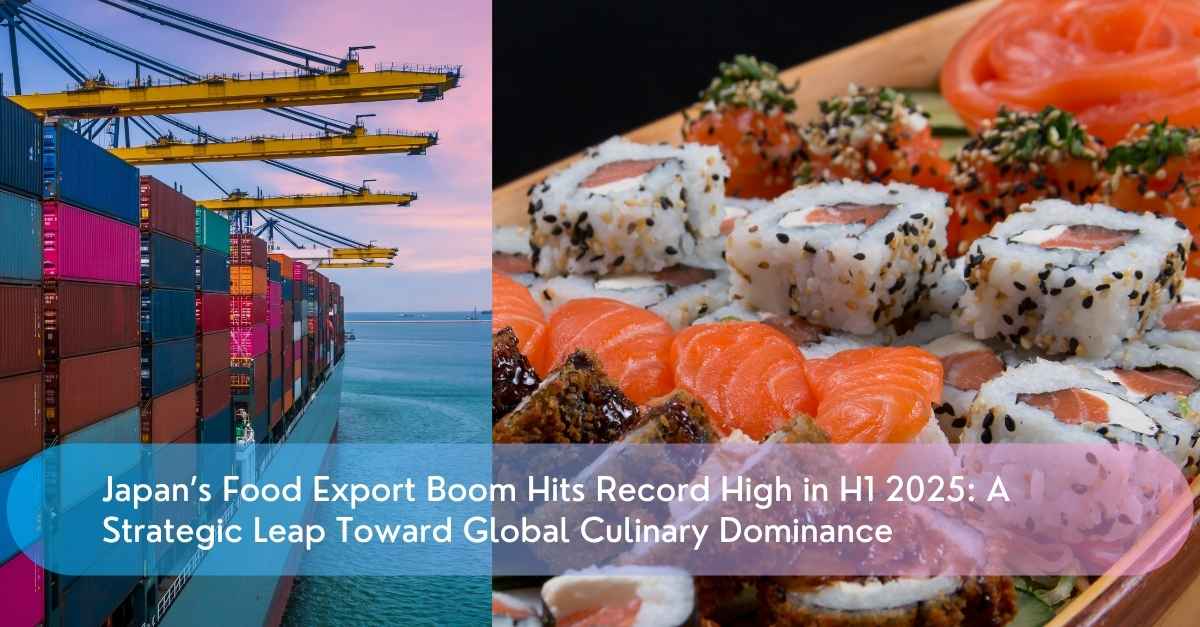4th August 2025, Japan
A New Era for Japan’s Agri-Food Industry
On 4 August 2025, the government and business players in Japan reported a historic milestone: Japanese food exports hit an all-time record during the first half of 2025, a clear indication of a strong shift in the economic and trade strategy of the nation. Total food exports, according to official statistics by the Ministry of Agriculture, Forestry and Fisheries (MAFF), exceeded previous records due to overseas appetite for Japanese seafood, wagyu beef, processed food, and native foods like miso, soy sauce, and sake boomed.
This export boom is more than a matter of economic figures it is Japan’s strategic positioning of its agri-food sector on the world-premium brand, fueled by cultural heritage, gastronomic quality, and strict quality control. This increasing Asian-Pacific neighbours’, North American, and several European hungers for premium food has justified Japan’s strategy to penetrate the world’s luxury and health-focused food markets. What distinguishes this momentum is the crossing over of tradition and innovation: tradition food culture is now added to high-tech agriculture technology, intelligent logistics, and aggressive overseas promotion. No longer do Japanese foods fill ethnic niche aisles; they are now commanding premium shelf space in upscale supermarkets, upscale restaurants, and direct-to-consumer channels around the world.
Government-funded initiatives like the Food Export Expansion Strategy drew in on this success to equip local farmers with the capability to fight through foreign red tape, lower quality barriers, and become taste and culture ambassadors in Japan. These are complemented by trade missions, bilateral deals, and increasing participation in overseas food shows, presenting additional opportunities for small- and medium-sized producers across Japan.
Key Drivers Behind the Export Surge
Multiple factors have converged to fuel this momentum:
- Tourism & Cultural Branding Recovery: The post-pandemic recovery of international tourism has re-sparked international travellers access to Japanese food culture. As they come back home with hunger for the quality and beauty of Japanese cuisine, global retail and hotel industries have witnessed a surge in demand.
- Government Export Drive: MAFF’s “Food Export Expansion Strategy” has made Japan’s high-value agri-food industry a cornerstone of national economic recovery. Assistance encompasses exporter subsidies, trade mission delegations, and expedited inspection procedures to comply with foreign standards.
- Premiumization of Japanese Products: From handcrafted soy sauce aged in cedar barrels to carefully marbled wagyu and gem-like Yubari melons, Japan is selling its heritage foods as aspirational lifestyle products. The “Cool Japan” campaign has assisted in positioning these exports as part of an umbrella luxury narrative.
- Globalized Diversified Market Presence: Though China, Hong Kong, and Taiwan continue to be key markets, the U.S., Thailand, UAE, and even European countries such as France and Germany are increasingly high-growth markets. Japanese cuisine appears more and more in global supermarkets, fine dining, and fusion cuisine establishments.
Seafood, Fruits, and Processed Foods: The Flagbearers
Seafood still dominates the export basket. In spite of ongoing doubts regarding post-Fukushima water discharge policies, scallops, bluefin tuna, and sea urchin are in high demand in the U.S. and Southeast Asia. Japanese fruits, in the form of high-end varieties of grapes, strawberries, and cherries, are also finding their way into record-breaking prices in international gourmet markets.
Processed foods, once a niche category, has become an unexpected growth driver. Ready-to-cook ramen packs, freeze-dried miso soup, and matcha desserts are gaining mass consumer bases among health-oriented, convenience-hungry foreign markets.
Structural Shifts Within Japan’s Agriculture Sector
To meet export volume and quality expectations, Japan is undergoing structural transformation at the production level:
- Agri-Food Tech Integration: Schools, food-tech companies, and traditional farmers are working together to create climate-resilient crop varieties, hi-tech fermentation technologies.
- Consolidation of farms and Smart Farming: New farmers are embracing robotics, precision irrigation, and AI-crop monitoring to increase yields and quality consistency.
- Cold Chain Innovation: State-of-the-art cold storage, temperature-controlling packages, and export-grade logistics investments improved Japan’s ability to provide perishable commodities globally with “just harvested” freshness.
Export Policy and Market Engagement
MAFF, along with the Japan External Trade Organization (JETRO), has implemented a three-tiered policy model:
- Uplifting product traceability, organic certification, and food safety to comply with EU and U.S. standards.
- Organizing Japanese food expos abroad, financing branding campaigns in department stores and online platforms.
- Negotiating bilateral arrangements to lower tariffs and simplify customs clearance for agri-food exports.
Additionally, public-private partnerships have increased, with major retail groups and logistic companies working alongside government agencies to ensure consistent product flow from farms to foreign consumers.
Outlook: From Niche to Global Culinary Powerhouse
The Japanese government has set its sights on a ¥5 trillion export target by 2030, up from the current record trajectory. Achieving this will require not only production scaling but also cultivating brand identity abroad making “Made in Japan” synonymous with purity, craftsmanship, and gastronomic prestige.
Key Highlights of Japan’s Food Export Surge:
| Parameter | Detail |
| Timeframe | January–June 2025 |
| Export Value | Record high (exact figures pending) |
| Leading Categories | Seafood, wagyu beef, fruits, processed foods |
| Growth Drivers | Government strategy, luxury food branding, tourism recovery |
| Key Markets | China, Hong Kong, Thailand, UAE, France, U.S. |
| Strategic Goal | ¥5 trillion in food exports by 2030 |
Broader Significance: Cultural Diplomacy Through Cuisine
Outside of commerce, this export surge functions as gastronomic diplomacy, exporting Japan’s cultural ethos of harmony, simplicity, and respect for nature. It also contributes to larger geopolitical objectives reinforcing alignment with trading partners through soft power.
As doors of more nations open to Japanese food and ingredients, and as global consumers turn to healthy, high-integrity food experiences, Japan’s food industry is well-positioned.
Final Outlook
Japan’s record-breaking food export performance in early 2025 highlights a country retooling its economic engines shifting from local limits to international horizons. With astute policy crafting, advanced logistics, and revitalized agricultural foundations, Japan is no longer merely sending out food it’s sending out identity.
If this trend continues, Japan’s food exports will in the near future not only be regarded as an economic success story, but also as a permanent proof of cultural superiority and international integration.











